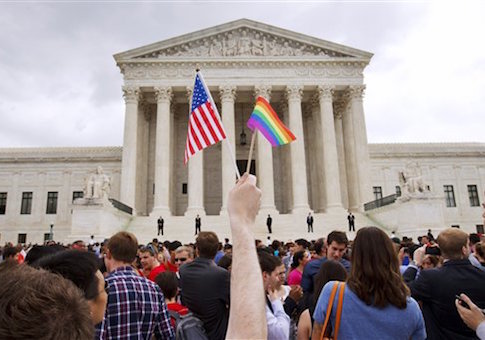On June 26, 2015, the Supreme Court released its decision in Obergefell v. Hodges, which allowed two people of the same sex to be issued marriage licenses in all fifty states. Months earlier during oral argument, Chief Justice John Roberts remarked, "Every definition that I looked up, prior to about a dozen years ago, defined marriage as unity between a man and woman as husband and wife. You’re not seeking to join the institution, you’re seeking to change what the institution is."
That quote encapsulates the view of a fresh and prominent millennial voice on the topic of marriage, Ryan T. Anderson, a senior fellow at the Heritage Foundation and Princeton graduate with a Ph.D. from Notre Dame. Anderson is on the target lists of many liberal groups, which is no surprise given the firm stance he takes on traditional marriage and the confidence and eloquence with which he argues in favor of it. His new book, Truth Overruled: The Future of Marriage and Religious Freedom, is to help people, clergymen, business owners, policy makers, and students alike to defend the traditional understanding of marriage and their right to exercise that belief. The book is also meant for those who disagree with Anderson in good faith in the hope that they might better understand his position.
Truth Overruled is organized into clear, digestible chapters that explain what marriage is and why it matters for public policy, religious freedom, and the promotion of the common good. Its arguments are not simply religious (Anderson is a Roman Catholic); they also draw upon history, legal philosophy, biology, social science, and many other disciplines. According to Anderson, one has to first know what the marriage relationship is and is intended to be before talking about what it means to recognize it legally. He describes two different visions of what marriage is: the traditional view that it is a comprehensive, exclusive, permanent union intrinsically ordered towards procreation by two sexually complementary persons; and a new consent-based view of it as an emotional, romantic, care-giving union for adults.
"If marriage is simply about consenting adult romance and caregiving," Anderson asks, "why should it be a sexually exclusive union?" This opens the door to give marriage rights to three or four consenting adults in a romantic relationship. It means that marriage can eventually become whatever the court wants it to be. Ultimately, he thinks, this will lead to the decline of marriage as a superfluous institution.
Anderson reminds us why government is in the marriage business in the first place. "The state is interested in marriage and marital norms because they protect children, strengthen civil society, and make limited government possible," he writes. Government promotes marriage to make man and woman responsible to each other and any children they have. Of course, this is not always possible, but Anderson argues that in principle society should never deprive children of their right to live with their natural biological families, among whom even secular social scientists believe they are most likely to thrive.
He is also clear in the book that he is not anti-LGBT, despite what many of his critics allege, but pro marriage as the institution has been defined comprehensively by cultures for millennia. His argument is not about excluding anyone from behaving as they see fit or freely entering into contracts with one another—he simply believes that these contracts should not be kept under the umbrella of "marriage."
His final argument is to protect the right for people and their businesses to live in accordance with the truth, and to be free to speak their beliefs about the union between a man and a woman without government coercion or penalty.
As Anderson shares in his book, there are several national examples where the negative consequences of the same-sex marriage ruling have already come to fruition with families losing their businesses for refusing to violate their beliefs. These businesses are not refusing to serve the LGBT community in general. It is only the act of supporting the couple’s ceremony that violates their deeply held belief. If the public did not want to support that business because of those beliefs, Anderson argues that is the freedom American society has, not the government. Truth Overruled shows that the battle for religious liberty is only beginning.
In closing, Anderson turns to abortion for an example of what he hopes will happen in the future with Obergefell. People thought that the issue was a dead letter after Roe v. Wade, but new restrictions on the practice are coming into place all the time, and a majority of Americans support a ban after 20 weeks. Pro-lifers have a valid place in the public debate, and Anderson hopes the same will be true for defenders of traditional marriage.
Truth Overruled encourages readers to remember that the debate is not over. It serves as a reminder that there are people of good will on both sides of the same-sex marriage argument and it should be our goal to win the respect of those who reject the traditional understanding of marriage as we exercise our constitutional rights to disagreement and dissent. As Anderson puts it, "Too many of our neighbors haven’t heard our arguments, and they seem unwilling to respect our rights, because they don’t understand what we believe. It’s up to us to change that perception. We will decide which side of history we are on."
This is a hopeful book. It reminds us that the conversation can continue, and that the culture can be rebuilt.
